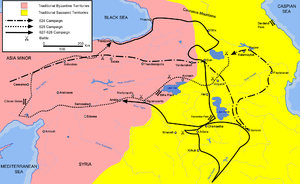| Heraclius' Caucasus campaign | |||||||||
|---|---|---|---|---|---|---|---|---|---|
| Part of the Byzantine–Sasanian War of 602–628 | |||||||||
 Heraclius' Campaigns against the Sasanians | |||||||||
| |||||||||
| Belligerents | |||||||||
| Byzantine Empire | Sasanian Empire | ||||||||
| Commanders and leaders | |||||||||
| Heraclius |
Khosrow II Shahrbaraz Shahin Shahraplakan | ||||||||
| Strength | |||||||||
| 24,000 | 70,000 | ||||||||
| Casualties and losses | |||||||||
| Unknown, possibly heavy | 46,000 to 70,000 | ||||||||
| Byzantine–Sasanian War of 602–628 | |
|---|---|
Heraclius' Caucasus campaign was an invasion of the Byzantine army into the Caucasus, which belonged to the Sassanids at that time, took place in the period from 624 to 625, as a result, the Greeks captured the Transcaucasia.
Background

Having won a victory over the Persians in Anatolia and concluded a peace treaty with the Avars, Heraclius began to prepare for a new campaign.On March 25, 624, he left Constantinople with the goal of capturing Armenia. Immediately before the campaign itself, the emperor of Byzantium made attempts to conclude peace with Khosrow, but nothing came of it.Heraclius, together with his new second wife and niece Martina and two of the children from his first marriage (with Fabia/Eudokia), departed from Constantinople on 25 March 624. He crossed to Chalcedon, then followed the route along the Sea of Marmara. His daughters Epiphania and Eudokia by his first marriage (but apparently not his son Heraclius Constantine) accompanied him as far as the vicinity of Nikomedia where they celebrated Easter on 15 April.
Campaign

In the spring of 624, Heraclius raised a new army and invaded Sasanian Armenia. Some primary sources claim that he raised an army of 120,000, but modern historiography has recognized these figures as overstated. Heraclius marched rapidly through Anatolia, along the way of the cities of Satalu, Theodosiopolis and Ayrarat. On the Aras, he destroyed the Dvin fortress. At that moment, he met Khosrow at Ganzak, one of the most important religious centers of the Persian state. In a short battle, the Byzantines won a complete victory and dispersed Khosrow's army. After the battle, they looted the palace in Ganzak in revenge for what the Persians had done to Jerusalem 10 years earlier. However, the campaign did not end there, Khosrow wanting to take revenge for the defeat, sent a large army to meet Heraclius. The army was commanded by the most prominent Sassanid generals who had shown themselves in campaigns earlier. At Archesh, the tired Byzantine army met the Persians, and immediately rushed into battle, but a false retreat lured the vanguard of the Byzantines into a trap and most of them died. Heraclius did not lose his head and decided to personally lead the cavalry to the attack, which even Shahrbaraz admired. This was successful and the Persians fled, almost the entire army had exterminated, Shahrbaraz himself was almost killed, he lost his entire treasury and even his harem. The Byzantines were even able to invade the north of Mesopotamia, but retreated under the onslaught of Persian troops. Byzantine army was drained of blood and Heraclius was forced to postpone the invasion of Persia until the following year.
Aftermath
The Byzantines won, but the war did not end there, the following year the Persians made a last attempt to attack right into the heart of Byzantium - Constantinople. He even called for the help of the Slavs and Avars, gathering an army of 80,000, but could not win, the Byzantines defeated the Slavs' fleet and the Persians were forced to give up leaving Anatolia. Seeing the successes of Heraclius, the Turks also entered the war, in the period from 627 to 628, Heraclius again won several brilliant victories, in Mesopotamia at the ancient city of Nineveh and in the siege of Tbilisi.
Reference
- Kaegi 2003, pp. 126–127.
- Greatrex 1991, p. 205.
- ^ Norwich 2023, p. 190.
- Kaegi 2003, pp. 120–122.
- Kaegi 2003, p. 125.
- Kulakovsky 1996, p. 58.
- Greatrex 1991, p. 200.
- ^ Ostrogorsky 2011, p. 152.
- Kaegi 2003, p. 130.
- Greatrex 1991, p. 204.
- Dashkov 2008, p. 178.
- Norwich 2023, p. 192.
- Ostrogorsky 2011, p. 153.
Bibliography
- Kaegi, Walter Emil (2003), Heraclius: Emperor of Byzantium, Cambridge University Press, ISBN 978-0-521-81459-1
- Greatrex, Geoffrey (1991). The Roman Eastern Frontier and the Persian wars.Part II.363-630AD. Routledge. ISBN 0-415-14687-9.
- Decker, Michael J. (2022). The Sasanian empire at War.Persia,Rome and the rise od Islam. Westholme Publishing,LLC. ISBN 978-1-59416-692-1.
- Norwich, John (2023). The History of the Byzantine Empire: From the foundation of Constantinople to the collapse of the state. Moscow: КоЛибри. ISBN 978-5-389-19591-2.
- Ostrogorsky, George (2011) . История Византийского государства [The History of the Byzantine State] (in Russian). Moscow: Сибирская Благозвонница. ISBN 978-5-91362-458-1.
- Kulakovsky, Julian (1996). История Византии: 602-717 [The History of the Byzantine: 602-717] (in Russian). Volume 3. Moscow: Алетейя. ISBN 5-89329-005-4.
- Dashkov, Sergei (2008). Цари царей: Сасаниды [The Sassanids: Kings of Kings] (in Russian). Moscow: Сми-Азия. ISBN 978-5-91660-001-8.
Notes
- The maximum size of the army in the Battle of Ganzak
- Two armies: the first under the command of Khosrow with 40,000, participated in the battle of Ganzak, and the second army sent in 625 under the command of Shahrabaraz with 30,000
- Ancient Greek: Η εκστρατεία του Ηρακλή στον Καύκασο; Persian: کمپین هراکلیوس در قفقاز
- Shahin, Shahrvaraz and Shahraplakan.
Minor explanations
- Kaegi gives an estimate of 6,000, however, he means the detachment that participated directly in the clash, above he calls the size of the invasion army with 30,000 Kaegi 2003, p. 129